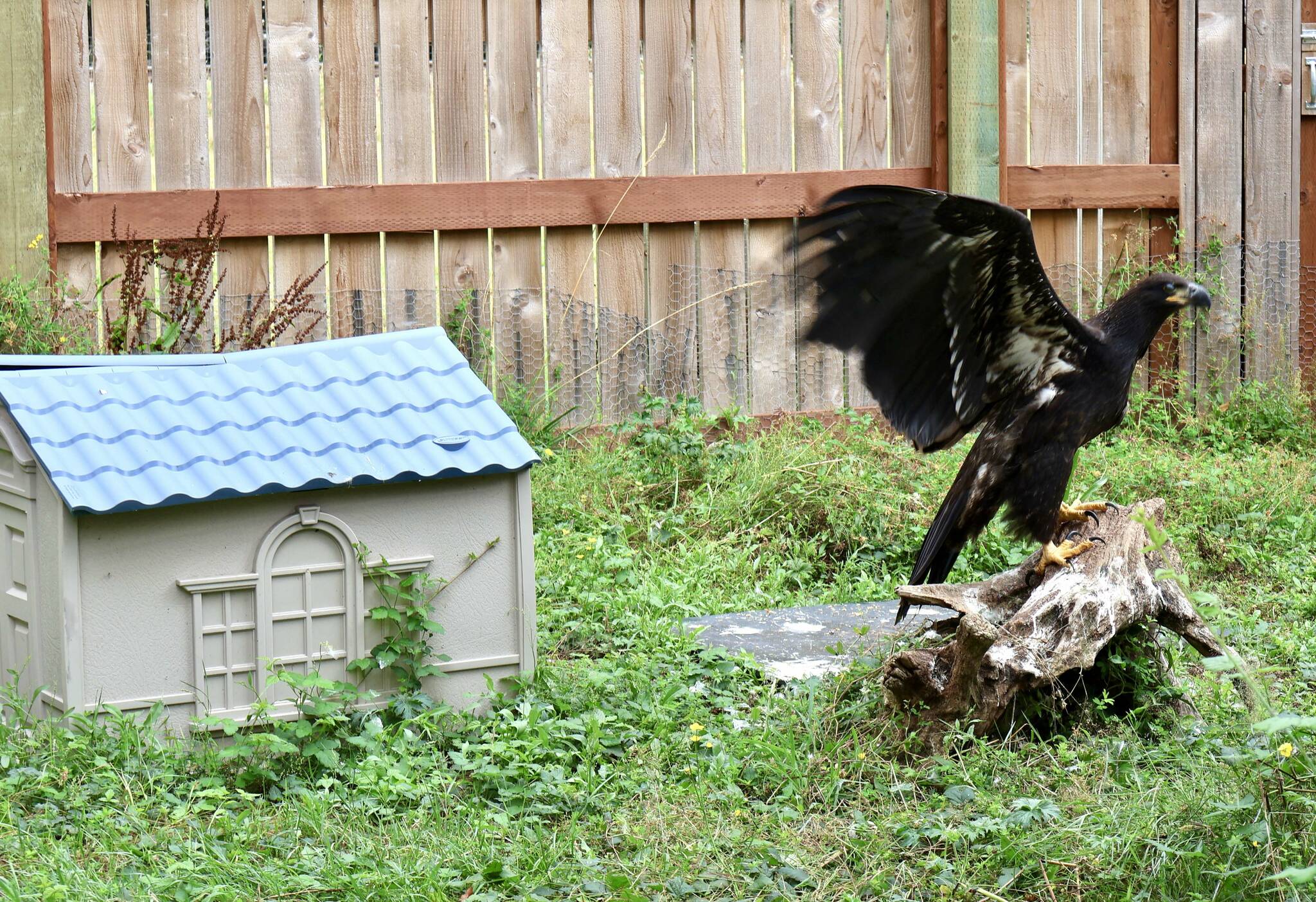Off U.S. Highway 12 in Montesano, to the north stands a sign, Twin Harbors Wildlife Center, next to the slatted walls of a bird enclosure.
Inside, a juvenile female bald eagle stares warily from atop a doghouse that’s approximately the size of the enormous bird, before flapping and hopping around the enclosure, just one of the many animals rehabilitating at the center before being released back into the wild.
“My favorite part is the release. Seeing them go from in need of help to helped and out the door,” said Bailey Davis, one of the volunteers at the center. “They’re helpless and we help them.”
Twin Harbors Wildlife Center has existed since 2019, the brainchild of Dr. Sonnya Wilkins and Dr. Corrie Hines, when it opened its doors early that year, said Amy Bledsoe.
“I’ve been here since the beginning,” Bledsoe said. “I started as a volunteer, then worked my way up to rehabber and trainer.”
The nonprofit center has helped all manner of bird and beast, including two bald eagles who are currently in residence, to seabirds and owls, to mammals from the inquisitive and adorable possums to energetic chipmunks and aromatic skunks. There are some peculiar exceptions — wildlife centers need to be permitted in certain ways to take in raccoons to mitigate disease risk, which Twin Harbors Wildlife Center is not, Bledsoe said.
“We take a variety. We have the skunks. We have the porcupine,” Bledsoe said. “If it’s an animal we’re not permitted for, we can stabilize it for transport. Shelters take animals that they’re better suited to.”
Other animals might be transported to other shelters that are better suited to handle them, such as those in Quilcene or Ocean Park Bledsoe said, using baby deer or bear cubs as examples, both of which have been brought to the rescue center before.
“As people learn about us and we grow, we get more and more,” Bledsoe said.
Even during the interview, calls keep coming in, ringing on both Bledsoe and the other trainee rehabber, Karla Kershaw’s phone — the business never stops.
Why a wildlife rescue?
It’s illegal in the state of Washington for non-licensed people to rehabilitate wildlife, Bledsoe said, and the certification process involves about 1,000 hours of working with the animals on top of testing, Bledsoe said. Much of that work involves learning what works and what doesn’t with animals across the age spectrum. Davis, Bledsoe noted, is particularly good at working with rabbits, who often fare poorly if they end up at a wildlife rescue.
“They have a high level of not surviving in rehab,” Bledsoe said. “They have high stress. (Davis is) really good with them.”
The baby bunnies require feeding two to three times a day, Davis said.
“(It’s) tedious. And satisfying. You have to have a lot of patience to feed the little bunnies,” Davis said. “Just in the last week, we’ve had 14 baby bunnies come in.”
Currently, the rescue center has several skunks, a possum, a chipmunk, baby rabbits, two juvenile bald eagles, an evening grosbeak, and of course, its resident porcupine, Tipsy. Tipsy, so named for her cerebellar hypoplasia, which makes her prone to falling over, is a permanent resident of the center, as she would not survive in the wild, Bledsoe said. Tipsy is the only named animal at the shelter; all others are just passing through as they’re rehabilitated for release back into the wild.
“It’s nice to be here to help them,” Davis said. “It’s a little hard on you too. I’d rather someone be here to help them.”
Every other animal, once nursed back to health, is released at carefully considered locations in the wild, Bledsoe said.
“We look for the criteria,” Bledsoe said. “We see if it has the trees, the water source, the food source, away from main roads, away from main people.”
One recent resident, a bald eagle, was released right near the rescue center, Bledsoe said.
“There was a male bald eagle in the flight pen. And we noticed a female bald eagle that would come by and they would talk back and forth and back and forth,” Bledsoe said. “We got special permission to release him on the property.”
The two eagles have been sighted in the area in each other’s company, Bledsoe said.
Plans for the future
The rescue center weathered the pandemic, Bledsoe said, and the demand for help for wildlife in distress never abated.
“We were a skeleton crew. That way it, minimized people getting sick,” Bledsoe said. “We made it through.”
The rescue center is looking to expand its capability as well as maintain its current operations, Bledsoe said. Originally, the rescue started in a shed. Now’s it expanded into an old vet clinic, while new outdoor hutches pop up in the adjacent field like mushrooms after the rain, with the largest and most obvious being the bird pen, the round, tall, wooden-slat building visible from U.S. Highway 12.
“We want to keep building outdoor enclosure. We want to keep adding mews on to the flight pen. Each mew can hold a raptor or an owl,” Bledsoe said. “It’s pretty much just doing what we’re doing, just expanding out into the field.”
They’re also looking to build a special enclosure for Tipsy, Bledsoe said, whose condition doesn’t allow her to climb safely.
The rescue center is funded by donations and grants, Bledsoe said, and always needs volunteers to add to its ranks of dozens who come in to help out. More information about volunteering or donating is available on the Twin Harbors Wildlife Center website or social media, Bledsoe said.




